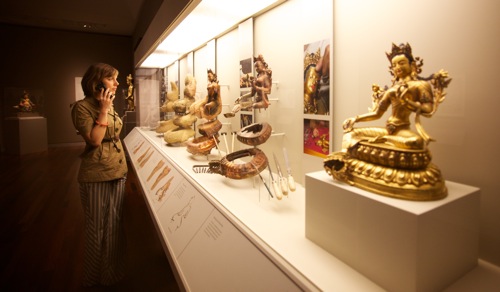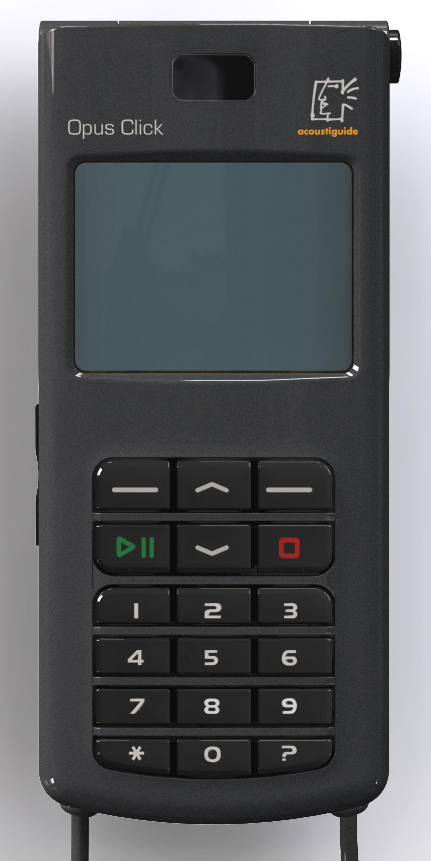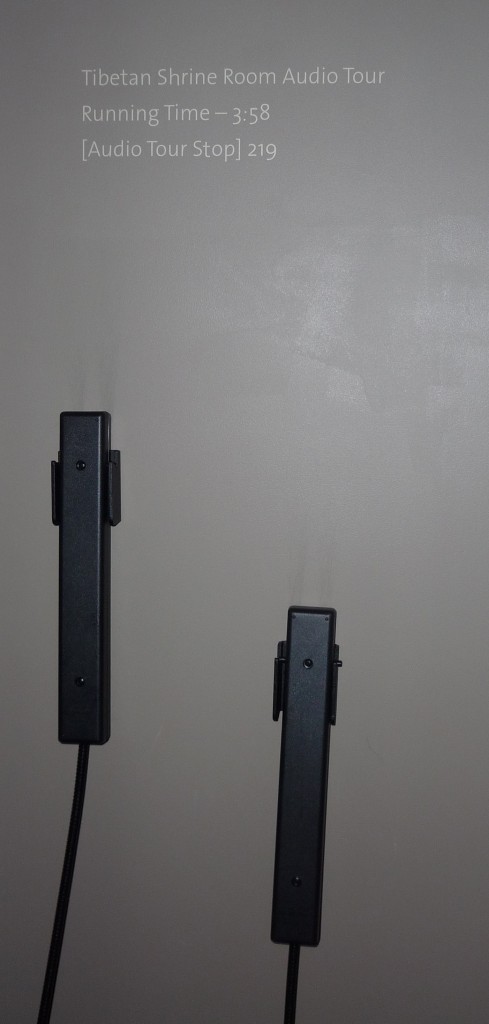When you go to a museum, what do you hear? Museums, like libraries, have a reputation to be places where you should “shush.” But if you listen closely, there’s a lot going on sonically in museums, both premeditated and spontaneous. Much of it forms the overall pedagogical environment and sound animates museums, showing them to be living, dynamic entities. When I stand at the top of the Rubin’s spiral staircase I hear evidence of people enjoying the museum: music and the clinking of glasses wafting up from the first floor cafe, a group of students on a tour with one of our educators, a guide in the gallery explaining a work of art to a small group of curious visitors, a pair of visitors discussing details they notice in a work of art, and, almost inaudible, the whisper of sound from an audio tour wand a visitor hold closes to her ear as she observes a work of art.
As the staff member who oversees the creation of the Rubin Museum of Art’s audio tours, when I hear this I feel as a small rush of pride. I spend a lot of my time thinking about the audio tours and not only what they say, but how they sound. As technology has advanced producing audio tours and podcasts has become easier and cheaper for many institutions. We produce most of our audio tours in-house (meaning, Marcos and I produce them ourselves) recording with a Samson CO1U USB Studio Condenser mic and Mac’s Garageband program. Since we don’t have a real recording studio (in my dreams) I often have to remove some ambient noise from the recordings. I have found Bias’ Soundsoap 2 software to do a pretty workable job in most cases, though not always. After the voice on the audio tour is sounding good, Marcos and I often add music for an interesting effect. Musician Aaron Shragge even recorded original music just for us to use on our Gateway to Himalayan Art audio tour.
We recently upgraded our audio tour system to Acoustiguide’s Opus Click units. Apart from the fact that these are mostly indestructible and allow you to include a small picture for each audio stop, my favorite part about them is I upload and manage all of the audio tour content myself through Acoustiguide’s very easy to use content management software. We used to have to complete our audio tours months in advance and send them to Acoustiguide to put “on the wands” as we say, but now I can finish them the week the show opens! We also recently installed 2 of Vista Group’s “Sound Sticks” outside of the Alice Kandell Shrine Room so that visitors could listen to a 3 minute audio interpretation of the shrine room and the objects in it. This made it so we would not have to put up a large didactic panel that would compete with the objects in the shrine room for viewers’ attention. Like our audio wands, I was able to simply load an MP3 onto the sound sticks.
So there’s a little bit about the how, but why? Honestly, I used to never take audio tours, but now I’m obsessed with them, especially since many institutions offer them for free via their websites or iTunesU. I am also a musician and a radio junkie. When I’m at my desk and not editing audio I’m listening to the BBC, WNYC, or Radio France Internationale. I find I absorb information rapidly when I hear it. I love it when someone (recorded or in person) tells me a story about a work of art and I can loose myself in looking and learn while I listen (storytelling is a whole other subject we can cover later).
To unlock some of the mysteries about why learning aurally can be so effective for many people I turned to one of my favorite education theorists: Howard Gardner, originator of the theory of multiple intelligences. Simply put, this theory demonstrates that different people learn in different ways and have particular strengths when learning. This sounds like common knowledge now, but when his book Frames of Mind was released in 1983 it changed the practice of educators around the world. About language Gardner says, “Linguistic competence is, in fact, the intelligencethe intellectual competencethat seems most widely and democratically shared across the human species… Much of teaching and learning occurs through language-at one time, principally through oral instructions, employing verse, collections of adages, or simple explanations…” (Gardner, Frames of Mind, p.78).
Gardner goes on to say in his Intelligence Reframed: Multiple Intelligences for the 21st Century that places like museums can especially benefit from the entry point language offers when engaging audiences and interesting exhibitions. Thankfully now this is fairly common practice and audio guides are an alternative entry point that has been utilized by many institutions for quite sometime. At the Rubin Museum of Art we use also use audio tours also provide a layer of information that there was not space to convey on the written labels, to approach the exhibition from another angle, to appeal to different learning styles and preferences, and to be accessible to many different kinds of audiences.
Howard Gardner sums up my hope for audio tours and all other resources I create and oversee for our galleries in this way, “Multiple intelligence theory assumes many routes to expertise, in school and out. The interventions favored for children’s museums, art museums, and other cultural institutions open up a variety of entry points and then, in turn, allow free use of one’s own strengths. Under favorable circumstances, museum visitors master these various points of entry and apply them broadly, even when exhibitions have not been crafted with such pluralism in mind… ” (Gardner, Intelligence Reframed, 190.
How do you use audio to provide multiple points of entry at your institution? How does hearing content delivered aurally help you as a learner?






6 Responses to Learning Through Listening: Audio in the Galleries